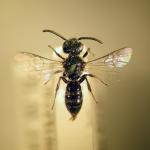Rhophites halictulus Nylander, 1852, Dufourea (Dufourea) halictula amethystina Ebmer, 2008
Dufourea is a genus closely related to Rophites, the two sometimes distinguishable only with difficulty. The taxonomy of the two British species of Dufourea was very confused, the present species being referred to as D. minuta in some older literature.
Only known from Surrey (Woking and Byfleet) and Dorset (Ferndown and Parley). However not found since 1920 in the former county and 1953 in the latter.
This bee is locally distributed in continental Europe from southern Sweden east to the Ukraine and Russia and south to the Iberian peninsula.
The species is classified as Endangered (RDB1) by both Shirt (1987) and Falk (1991).
The few known sites are sandy heaths.
Univoltine. The known flight period is late June to July, although from very limited data. The males apparently appear about a week before the females, unlike the case in Halictus and Lasioglossum.
This is a mining bee which, according to Mortimer (1913), “excavated its burrows between stones chiefly on a hard sandy pathway, less frequently in an adjoining sandy moss-covered bank”.
In Britain only sheep’s-bit is known but in Europe various bellflowers and a species of knapweed are also recorded.
No data available.
2012


